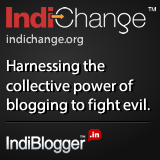Project Chirag -When The Youth Lights Up India
Mohan Bhargava, the reel-life NASA scientist portrayed by Shah Rukh Khan in Swades who lights up his native village using hydro power can take a walk. A bunch of young college students — no scientists, these — have done the same in real life, in a simple, innovative way through their passion, innovation and ingenuity.
 The striking part, though, is the speed with which they have executed their idea. They conceptualized it on January 11, 2010, and by March 12 had accomplished their task of lighting up 82 out of a total of 111 homes in a tribal village in Thane district of Maharashtra.
The striking part, though, is the speed with which they have executed their idea. They conceptualized it on January 11, 2010, and by March 12 had accomplished their task of lighting up 82 out of a total of 111 homes in a tribal village in Thane district of Maharashtra.
What’s praiseworthy is that in less than 100 days a group of 250 college students managed to win the faith of the tribals — without which Project Chirag (more about it later) would have been a “super flop” — raised a “humongous amount of money” (their own words), selected a vendor who gave them the technology to produce quality solar lamps, trained a disadvantaged section to assemble the lamps, trained their own volunteers to impart training to the assemblers, transported and installed solar lamps in this village and sold these lamps that costs them Rs 3,650 a piece for just Rs 500 to make Project Chirag a reality.
In doing so, they have created a value chain of several disadvantaged communities — both rural and urban — that has the true potential to transform the country’s landscape.

According to some estimates, approximately 400 million people in India do not have access to electricity and it is this gap these students aim to bridge.
With guidance and encouragement from their college Professor Pratibha Pai and Principal Indu Shahani (Hon. Sheriff of Mumbai), more than two score students of HR College of Commerce & Economics lit up Ujjaini, a tribal ‘dark village’ deep in the forest, spread across a radius of two km and made up of 111 households, barely 110 km from India’s financial capital Mumbai in Wada tehsil in Thane district.
Rediff.com met five of these activists — Jyotirmoy Chatterji, Prachi Bali, Abhinav Mehra, Afsheen Irani and Pawan Bhatia (all under 23 years of age) — in their college canteen to discuss Project Chirag started by the Students In Free Enterprise, HR College.
Project Chirag
“A village that does not have any source of electricity or does not have even one electrified household. is a ‘dark village’,” explains Jyotirmoy, a third year commerce student and president of SIFE, HRC.
“Project Chirag is about lighting up rural life using clean and sustainable solar energy,” he says.
And these volunteers chose Ujjaini out of a list of 30 dark villages in Thane district that the Tata Energy Research Institute provided them with “because the tribal folks here have never seen light in their entire life”.
The solar lamp unit is a portable LED (light emitting diode) device that comprises a solar lantern, a battery inside protective casing, a tubelight and two solar panels that capture sunlight and convert it into light energy.
“All one has to do is put two panels on the rooftops of these tribal houses where one can get maximum sunlight, connect the wires coming out of these panels into a battery which in turn energises the tubelight and lantern and they are ready to go,” says Afsheen, a second-year student at HRC who has trained many tribals in Ujjaini to work on these lamps.
SIFE HRC, established in 2008, was initially concentrating more on urban projects. But soon the volunteers felt the need to glance at exploring sustainable business models for rural development as “a majority of Indians still live in its villages”.
“So when we got a list of dark villages from TERI we randomly picked up one village that was populated and without any kind of guidance took a car and wandered into the forests to find Ujjaini,” says Abhinav, Jyotirmoy’s classmate.
After coming back from Ujjaini they decided to work on a five-point transformation model that was scalable and could be applied to any dark village in rural India.
This five-point plan would look at a holistic solution to transform rural lives and provide for:
– Solar electrification
– Health and sanitation
– Education
– Economic upliftment and
– Social development
“Phase I of Project Chirag is to electrify dark villages using solar lighting because achieving the remainder of the four points in the transformation model depend on lighting up villages first,” says Prachi, a third-year commerce student.
During their trip to Ujjaini the students found that the tribals spent a lot of the day, their productive period, going into the forests to collect firewood to light up their homes or cook food.
“So we thought introducing solar lighting would help them use their time productively,” explains Prachi.
Learn more on Project Chirag Click here

Source :Project Chirag
Article credits to : Rediff.com
Author : Prasanna D Zore .
Image credits : Project Chirag.com




You must be logged in to post a comment.